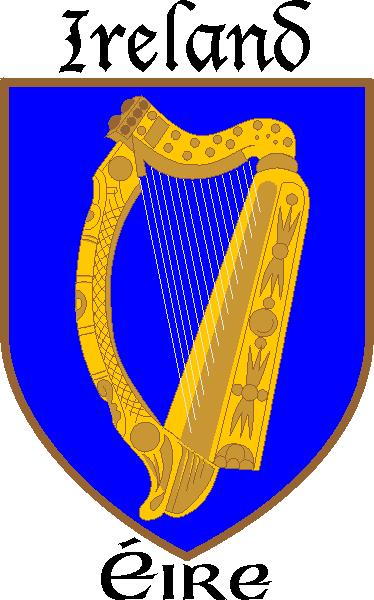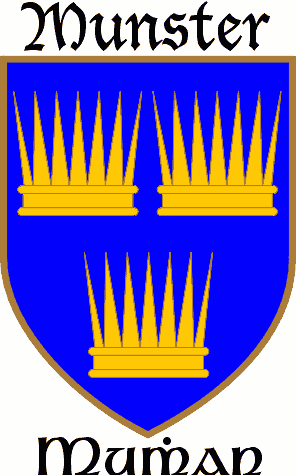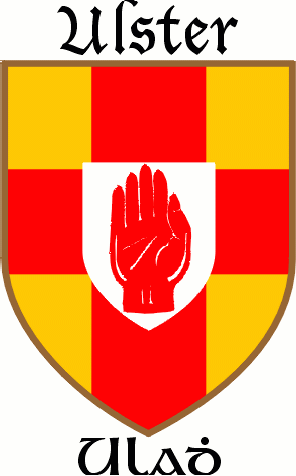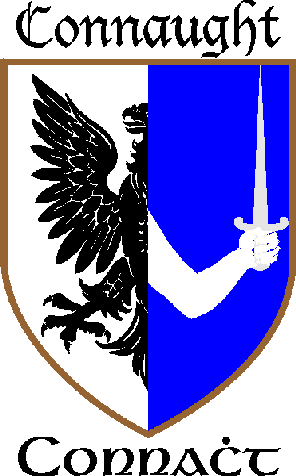Ireland Connaught Leinster Munster Ulster Coat of Arms

The arms are not officially recorded, but have been used for centuries as the arms of Ireland. The gold harp on blue is attributed to the King of Ireland ('le Roi d'Irlande') in one of the oldest medieval rolls of arms, the Wijnbergen Roll (a Flemish roll of arms dating from c. 1280). The harp, traditionally associated with King David, was a rare charge in early medieval rolls. Léon Jéquier's ordinary of 19 early rolls (in Cahiers d'Héraldique) has only two arms with a harp, the Irish coat of arms in the Wijnbergen roll, and the Steinach family in the Zurich roll of arms c.1340.
The harp is in fact the O'neill's harp dating from the tenth century at least, but is generally known as the Brian Bó Rúadh harp, for a famous Irish king, who died in 1014. It is located in the Trinity college library in Dublin.
The Four Ancient Provinces Of Ireland
 |
 |
The Ancient Irish Province of Munster
The ancient province of Munster is the Southerly Province of Ireland, consisting of the Counties of Cork, Clare, Kerry, Limerick, Tipperary and Waterford. With a total population of a little over one million, Munster houses fewer residents than that of County Dublin further north.
The Ancient Irish Province of Ulster
Ulster is the Northerly Province of the island of Ireland. Encompassing the Counties of Donegal, Cavan, Monaghan, Fermanagh, Tyrone, Derry, Antrim, Down and Armagh, Ulster was originally known by the Celtic name of Ulaid (Ulster in English). The earliest written sources about the history of Ulster date back to the 7th century.
The Counties of Antrim, Fermanagh, Tyrone, Derry, Down and Armagh make up present day Northern Ireland. A diverse Province with a population in excess of 1,800,000, Ulster closely follows Leinster as the most populous area in the island of Ireland. The principal business centre being the grand City of Belfast.
 |
 |
The Ancient Irish Province of Leinster
The only twelve County Province in Ireland is nestled on the Eastern seaboard. Derived from the old Irish word Laigin, Leinster houses the most densely populated County of Ireland and indeed its capital city, Dublin. The population of Leinster now stands at over 1.8 million.
Historically, County Meath, now part of Leinster, is the ancient seat of the High Kings with its infamous capital of Tara and the early Celtic site of Newgrange.
Encompassing the Counties of Carlow, Dublin, Kildare, Kilkenny, Laois, Longford, Louth, Meath, Offaly, Westmeath, Wexford and Wicklow, the Province of Leinster's landscape is as diverse as its Counties, from expansive farmland in the North to the dramatic Wicklow Mountains to the South.
The Ancient Irish Province of Connaught
The province of Connaught (Connacht) lies in the West of Ireland with its coastline on the Atlantic Ocean. The Counties of Mayo, Sligo, Leitrim, Galway and Roscommon are within its boundary. Connaught is the least inhabited province in Ireland with a population of just over 400,000.
Historically, Connaught has retained its rich Gaelic heritage and today still has communities where the Irish language is spoken. These regions are collectively called the Gaeltacht. The remote Aran Islands off the mainland of County Galway are part of the Gaeltacht.
The primary business centre of Connaught, and most densely populated area, is the thriving city of Galway to the south of the province. Connaught has some of the most beautiful and unspoilt countryside to be found in Ireland, including the spectacular mountainous landscape of Connemara.
Thanks and Acknowledgement to The International Civic Heraldry Website
The IBD Home Page and each IBD County Page has or will have (where possible) the relevant Coat of Arms. This is made possible thanks to a fantastic heraldry website called the International Civic Heraldry Website. Sometimes a description is not given due to lack of information, so if anyone could help it would be greatly appreciated. You may visit this superb site by using the link below.
